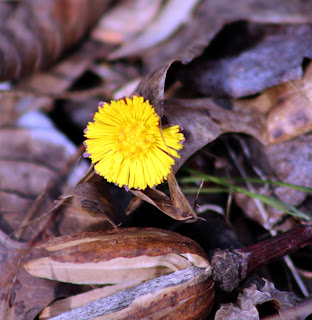Last weekend, I attended the winter field trip for VSO (Virginia Society of Ornithology) in Nags Head, North Carolina. The weather was cold and windy late Friday afternoon when I arrived. I didn't see anybody I knew so I went off to find a restaurant. Nags Head looked like a ghost town except for the few bright lights of a couple of restaurants. Seriously, most of the hotels, shops and restaurants were closed for the season and the many houses looked dark.
We were up bright and early Saturday to look for birds along Cape Hatteras beach. Before we headed out, I saw a humpback whale from the hotel deck--my very first sighting. I didn't get a photo but someone else could see the humpback with his binoculars to identify it. The whale seemed to be traveling with dolphins.

While walking back to my car, I spotted this
Savannah Sparrow (I believe that's what it is).
But I am not a serious birder because I keep getting distracted by things like lovely sand dunes.
I should apologize for leaving the group after a few hours to explore on my own. On the way back up to Nags Head, I spotted these Trumpeter Swans.
I stopped by Jockey's Ridge State Park to take in the huge sand dune. Do you see the two tiny people walking on the dune? You can see them if you click on the photo to get full resolution. I didn't take the trail but made special note for one of our future trips when my husband retires.
I walked on Jeanette's Pier, thinking I might grab some lunch but to no luck as the snack bar was closed. The wind turbines caught my attention. I had seen them in several places in Nags Head and noted that each one generates about 35kW a day or enough to power a house. I wonder why we don't see more of these in places like Virginia Beach.
About 30
Common Grackles were enjoying the pier, many more than the few people I saw.
When I arrived back at my room at the Comfort Inn, I noticed this out on the beach. I thought it was a seal.
But no, it was a huge dead fish that had washed up on the beach. Another guy had showed up with a shovel to scrape off the sand on the back part of the fish because we thought we we were only seeing about half the fish. We were surprised to discover it was just a small fin. How does this fish swim? More about this find later....
I rejoined the group at Bodie Island Lighthouse.
Back behind the lighthouse, the wetlands were full of birds like these hundreds of swans.
Back right before sunset, a group of James Madison students who had been along on the VSO trip identified the dead fish as an
Ocean Sunfish.They didn't know why it had died but they ruled out the fish being hit by a boat propeller as I had speculated because of the marks on the fins. One student said the soft fins were probably scaped on the ocean floor while it gradually came to shore. The rest of the body was so tough so it showed no signs of scraping (but sea gulls had worked on the eyes and mouth by then). One student also said this was a small fish as some ocean sunfish can weigh up to 900 lbs.I liked the way these students thought--like real scientists. I learned more about ocean sunfish on this website
"10 Facts About Ocean Sunfish."
I walked along the beach as the sun set. It was so different than when we visit the beach in August when there are hundreds of beach combers.
It was easy to find the hotel since it is close to Jeanette's Pier.
This was the first time I visited North Carolina's Outer Banks in the wintertime. The lack of crowds on the beach and cars on the road makes it very inviting. On Sunday morning, I spotted dolphins from my window at the hotel before I left for snowy Virginia.























